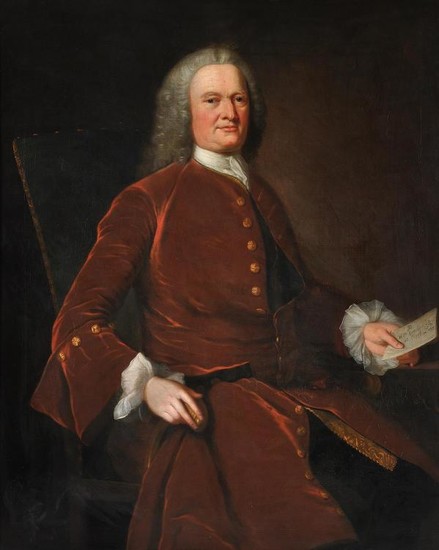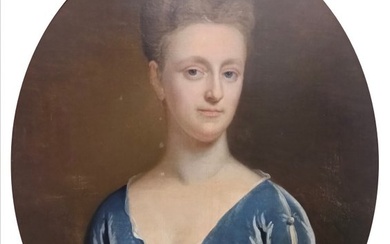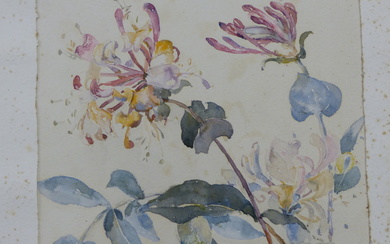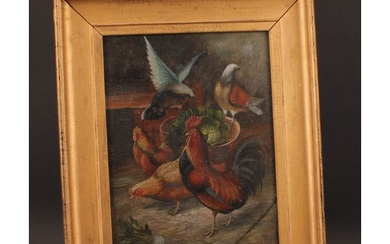English School (Early 18th century), Portrait of William Morland Esq (1692-1774) holding the deed to Court Lodge
English School (Early 18th century)
Portrait of William Morland Esq (1692-1774) holding the deed to Court Lodge
Oil on canvas
Inscribed to letter in sitter's left hand
126 x 102.5cm (49½ x 40¼ in.)
Provenance:
Property of the Morland Family, Court Lodge, Kent
William Morland was the first of the family to own Court Lodge. He purchased it from the Porter/Hamby family in 1733. It is thought that William demolished the original building and rebuilt in its current form, from stone that was most likely quarried from the grounds. The new structure was built in the fashionable Queen Anne style that was popular in William's native Westmorland but not very well known at that time in Kent.
William Morland married Ellen Johnson in 1724. Ellen was the daughter of Sir Thomas Johnson (1664-1728), a wealthy merchant and politician who is considered the founder of the modern city of Liverpool and heavily involved in the city's trade in Virginia tobacco.
William and Ellen had three daughters, Elizabeth, Mary and Ellen, and one son, Thomas.
Court Lodge
The following group of paintings comprise the collection of the Morland family. Court Lodge is a Georgian manor house in Lamberhurst in Kent and was the family seat of the family from the early 1730s until earlier this year. The paintings are testament to a rich family heritage with notable connections, both aristocratically and culturally, and serve as a historical record of the family's time at Court Lodge.
Court Lodge originally came into the possession of the Morland family in 1733 when William Morland, of the village of Morland in Westmorland, purchased the house from the Porter family. It is believed that William Morland tore down the original building and rebuilt it in the popular Queen Anne style to be the structure that stands today. The Morland family were lords of Lamberhurst Manor (as it was known) until 1935 when it was disenfranchised and reverted back to its original status prior to 1166 of an estate.
History has shown that the Morland men married well. William Morland, the first Morland of Court Lodge, married Ellen Johnson, daughter of Sir Thomas Johnson. He was a wealthy merchant and politician, largely attributed with the founding of the modern city of Liverpool. As we go further down the generations, we find other interesting marriages and alliances being formed.
Property of the Morland Family, Court Lodge, Kent (Lots 80-110)
The Courtenay Connection In 1812, Colonel Charles Morland, grandson of William Morland, married Lady Caroline Eustatia Courtenay, the daughter of Viscount William Courtenay, 8th Earl of Devon. Charles was Aide-de-Camp to King George IV and a senior rank in the army. The marriage was, once again, an extremely good match for the Morland family, the Courtenays being one of the foremost families of the south west with a substantial estate at Powderham Castle. The Courtenays had come over to England from France with Eleanor of Aquitaine, wife of Henry II in 1152. Two of the paintings in the sale (lots 102 and 103) are copies of originals held at Powderham and undoubtedly came into the Morland family via Lady Caroline, most probably replicas made on the occasion of her marriage.
Court Lodge's Literary Connections It had long been known in the Morland family that there were links to the family of the author Jane Austen. Thomas Morland (1734-1784) and Ann Matson (1745-1808) had a total of eight children, with seven surviving into adulthood. Of these seven, at least five married either directly into the Austen family or into families that had significant links to the Austens. The clearest connection comes from the youngest daughter, Margaretta (1777-1825). She married Jane Austen's second cousin, Colonel Thomas Austen and whilst there is much speculation as to how close the two parts of the family were, it does seem that Jane was at least knowledgeable enough to include a note in one of her letters: "Our cousins Col. Thomas Austen and Margaretta are going Aid-de-Camps to Ireland and Lord Whitworth goes in their train as Lord Lieutenant - good appointments for each" (Jane Austen's Letters, 4th edition, collected and edited by Dierdre Le Faye, Oxford, 2011, p. 226). It is also interesting, but perhaps purely coincidental, that the heroine of Northanger Abbey is called Catherine Morland. The novel is largely set in Bath and Thomas and Margaretta were married in Bath. Other children of Thomas Morland, married into the Marriott, Smith and Farnaby families, all of which were intimately connected with the Austens.
Moving down the generations into the twentieth century, another significant literary figure emerges in the history of Court Lodge. Poet and writer Siegfried Sassoon who is known primarily for his uncompromising depictions of life on the western front during the First World War, was born and lived in Matfield, not far from Lamberhurst. Sassoon's poetry earnt him praise and criticism in equal quantity, especially as his bleak portrayals were coupled with an unbridled contempt for what he saw as unjustified patriotic pretensions that fuelled the continuation of the war. In 1917 he was admitted to a psychiatric hospital where he met fellow poet Wilfred Owen. As well as his poetry, Sassoon is also known for his memoirs and it is here that the links to Court Lodge become apparent. His trilogy, collectively known as The Complete Memoirs of George Sherston are a fictionalised autobiography describing his early life in Kent. He was well acquainted with Lamberhurst which he calls 'Amblehurst' and with the Morland family which he refers to as the 'Maundle' family with 'Old Squire Maundle' being William Courtenay Morland. There are many anecdotes and references throughout the books to the frequent trips made to 'Amblehurst' and to the exploits of the 'Maundle' family.
Sale price
Estimate
Time, Location
Auction House
English School (Early 18th century)
Portrait of William Morland Esq (1692-1774) holding the deed to Court Lodge
Oil on canvas
Inscribed to letter in sitter's left hand
126 x 102.5cm (49½ x 40¼ in.)
Provenance:
Property of the Morland Family, Court Lodge, Kent
William Morland was the first of the family to own Court Lodge. He purchased it from the Porter/Hamby family in 1733. It is thought that William demolished the original building and rebuilt in its current form, from stone that was most likely quarried from the grounds. The new structure was built in the fashionable Queen Anne style that was popular in William's native Westmorland but not very well known at that time in Kent.
William Morland married Ellen Johnson in 1724. Ellen was the daughter of Sir Thomas Johnson (1664-1728), a wealthy merchant and politician who is considered the founder of the modern city of Liverpool and heavily involved in the city's trade in Virginia tobacco.
William and Ellen had three daughters, Elizabeth, Mary and Ellen, and one son, Thomas.
Court Lodge
The following group of paintings comprise the collection of the Morland family. Court Lodge is a Georgian manor house in Lamberhurst in Kent and was the family seat of the family from the early 1730s until earlier this year. The paintings are testament to a rich family heritage with notable connections, both aristocratically and culturally, and serve as a historical record of the family's time at Court Lodge.
Court Lodge originally came into the possession of the Morland family in 1733 when William Morland, of the village of Morland in Westmorland, purchased the house from the Porter family. It is believed that William Morland tore down the original building and rebuilt it in the popular Queen Anne style to be the structure that stands today. The Morland family were lords of Lamberhurst Manor (as it was known) until 1935 when it was disenfranchised and reverted back to its original status prior to 1166 of an estate.
History has shown that the Morland men married well. William Morland, the first Morland of Court Lodge, married Ellen Johnson, daughter of Sir Thomas Johnson. He was a wealthy merchant and politician, largely attributed with the founding of the modern city of Liverpool. As we go further down the generations, we find other interesting marriages and alliances being formed.
Property of the Morland Family, Court Lodge, Kent (Lots 80-110)
The Courtenay Connection In 1812, Colonel Charles Morland, grandson of William Morland, married Lady Caroline Eustatia Courtenay, the daughter of Viscount William Courtenay, 8th Earl of Devon. Charles was Aide-de-Camp to King George IV and a senior rank in the army. The marriage was, once again, an extremely good match for the Morland family, the Courtenays being one of the foremost families of the south west with a substantial estate at Powderham Castle. The Courtenays had come over to England from France with Eleanor of Aquitaine, wife of Henry II in 1152. Two of the paintings in the sale (lots 102 and 103) are copies of originals held at Powderham and undoubtedly came into the Morland family via Lady Caroline, most probably replicas made on the occasion of her marriage.
Court Lodge's Literary Connections It had long been known in the Morland family that there were links to the family of the author Jane Austen. Thomas Morland (1734-1784) and Ann Matson (1745-1808) had a total of eight children, with seven surviving into adulthood. Of these seven, at least five married either directly into the Austen family or into families that had significant links to the Austens. The clearest connection comes from the youngest daughter, Margaretta (1777-1825). She married Jane Austen's second cousin, Colonel Thomas Austen and whilst there is much speculation as to how close the two parts of the family were, it does seem that Jane was at least knowledgeable enough to include a note in one of her letters: "Our cousins Col. Thomas Austen and Margaretta are going Aid-de-Camps to Ireland and Lord Whitworth goes in their train as Lord Lieutenant - good appointments for each" (Jane Austen's Letters, 4th edition, collected and edited by Dierdre Le Faye, Oxford, 2011, p. 226). It is also interesting, but perhaps purely coincidental, that the heroine of Northanger Abbey is called Catherine Morland. The novel is largely set in Bath and Thomas and Margaretta were married in Bath. Other children of Thomas Morland, married into the Marriott, Smith and Farnaby families, all of which were intimately connected with the Austens.
Moving down the generations into the twentieth century, another significant literary figure emerges in the history of Court Lodge. Poet and writer Siegfried Sassoon who is known primarily for his uncompromising depictions of life on the western front during the First World War, was born and lived in Matfield, not far from Lamberhurst. Sassoon's poetry earnt him praise and criticism in equal quantity, especially as his bleak portrayals were coupled with an unbridled contempt for what he saw as unjustified patriotic pretensions that fuelled the continuation of the war. In 1917 he was admitted to a psychiatric hospital where he met fellow poet Wilfred Owen. As well as his poetry, Sassoon is also known for his memoirs and it is here that the links to Court Lodge become apparent. His trilogy, collectively known as The Complete Memoirs of George Sherston are a fictionalised autobiography describing his early life in Kent. He was well acquainted with Lamberhurst which he calls 'Amblehurst' and with the Morland family which he refers to as the 'Maundle' family with 'Old Squire Maundle' being William Courtenay Morland. There are many anecdotes and references throughout the books to the frequent trips made to 'Amblehurst' and to the exploits of the 'Maundle' family.







